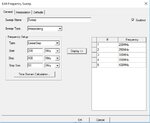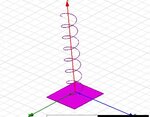baby_1
Advanced Member level 1
Hello
I have designed a mono helical antenna in HFSS with these settings:
Solution type riven
riven
a Helix with these settings

and "analysis" option:


and frequency sweep:

and here is my design

but it takes more than 3 hours to analyze it.(a core2quad cpu 2.5Ghz and 4Gig RAM)
1)why did it too long take?
2)how can decrease the analysis's time?
3)if our design doesn't convergence ,what does it cause?
I have designed a mono helical antenna in HFSS with these settings:
Solution type
a Helix with these settings

and "analysis" option:


and frequency sweep:

and here is my design

but it takes more than 3 hours to analyze it.(a core2quad cpu 2.5Ghz and 4Gig RAM)
1)why did it too long take?
2)how can decrease the analysis's time?
3)if our design doesn't convergence ,what does it cause?
